新概念英语第二册Lesson 57 Can I help you, madam? 课件(共19张PPT)
文档属性
| 名称 | 新概念英语第二册Lesson 57 Can I help you, madam? 课件(共19张PPT) |  | |
| 格式 | pptx | ||
| 文件大小 | 1.6MB | ||
| 资源类型 | 教案 | ||
| 版本资源 | 新概念英语 | ||
| 科目 | 英语 | ||
| 更新时间 | 2025-05-21 17:41:25 | ||
图片预览


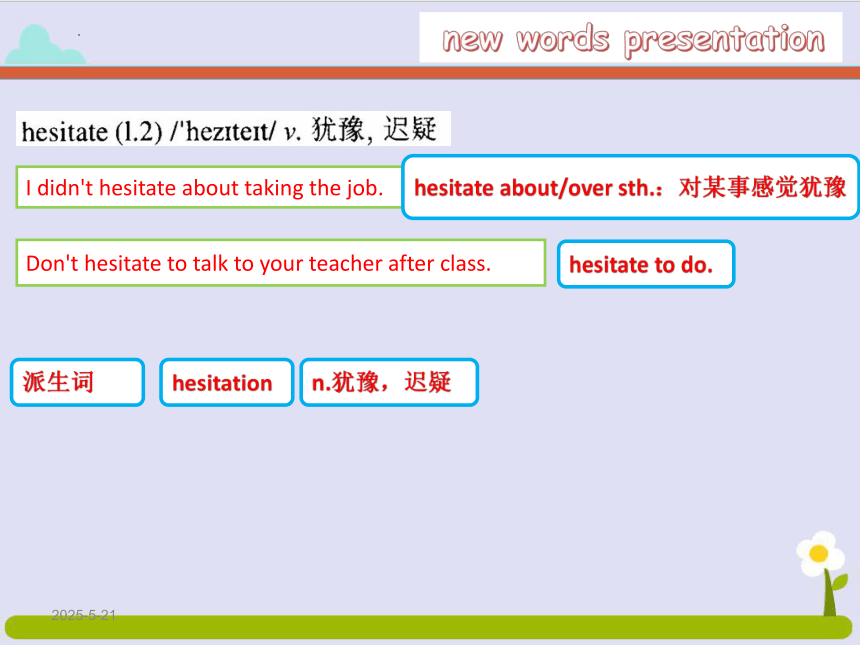
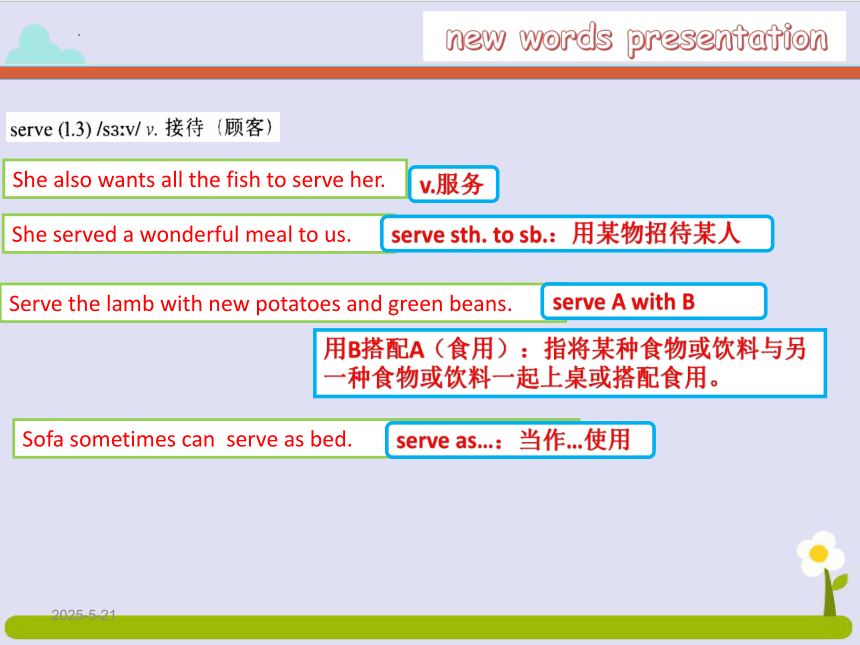
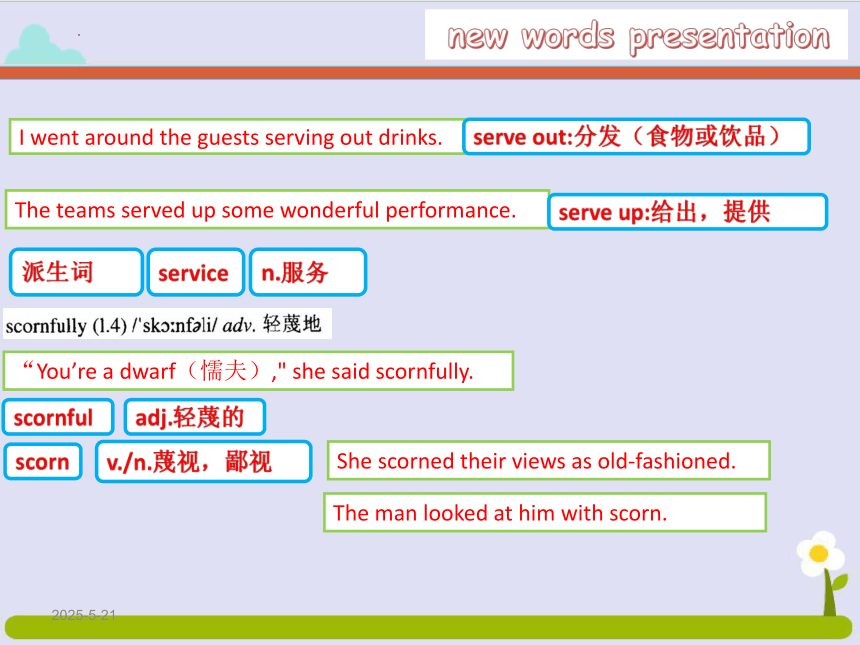
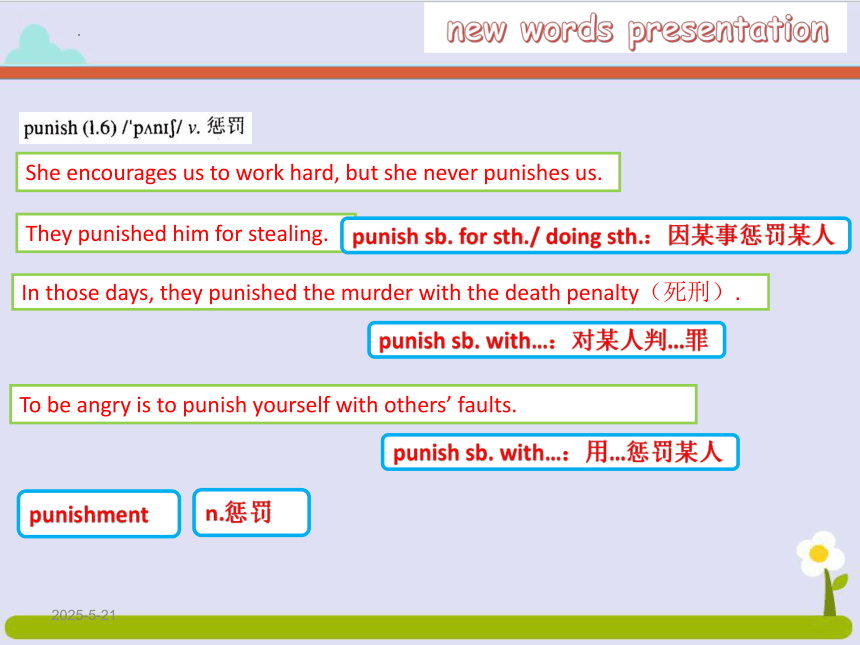
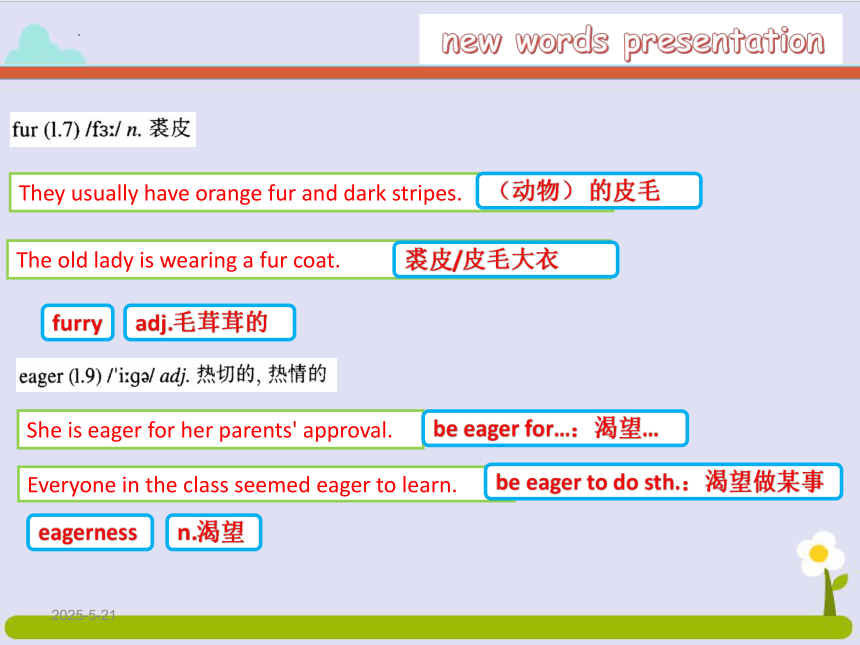
文档简介
(共19张PPT)
Lesson 57
Can I help you madam
2025/2/14
new words presentation
如果是店员对女顾客的称呼,后面不加姓名。
如果已知对方的身份或姓名可在此词后面加上姓名职位
She's a little madam—don't let her order you around
n.自我的,喜欢指使别人的年轻女性
pants
常用词,各类裤子
trousers
长裤,场合较为正式
shorts
短裤
2025/2/14
new words presentation
I didn't hesitate about taking the job.
hesitate about/over sth.:对某事感觉犹豫
Don't hesitate to talk to your teacher after class.
hesitate to do.
派生词
hesitation
n.犹豫,迟疑
2025/2/14
new words presentation
She also wants all the fish to serve her.
She served a wonderful meal to us.
serve sth. to sb.:用某物招待某人
Serve the lamb with new potatoes and green beans.
serve A with B
用B搭配A(食用):指将某种食物或饮料与另一种食物或饮料一起上桌或搭配食用。
Sofa sometimes can serve as bed.
serve as…:当作…使用
v.服务
2025/2/14
new words presentation
I went around the guests serving out drinks.
serve out:分发(食物或饮品)
The teams served up some wonderful performance.
serve up:给出,提供
派生词
service
n.服务
“You’re a dwarf(懦夫)," she said scornfully.
scornful
adj.轻蔑的
scorn
v./n.蔑视,鄙视
She scorned their views as old-fashioned.
The man looked at him with scorn.
2025/2/14
new words presentation
She encourages us to work hard, but she never punishes us.
They punished him for stealing.
punish sb. for sth./ doing sth.:因某事惩罚某人
In those days, they punished the murder with the death penalty(死刑).
punish sb. with…:对某人判…罪
To be angry is to punish yourself with others’ faults.
punish sb. with…:用…惩罚某人
punishment
n.惩罚
2025/2/14
new words presentation
They usually have orange fur and dark stripes.
(动物) 的皮毛
The old lady is wearing a fur coat.
裘皮/皮毛大衣
furry
adj.毛茸茸的
She is eager for her parents' approval.
be eager for…:渴望…
Everyone in the class seemed eager to learn.
be eager to do sth.:渴望做某事
eagerness
n.渴望
2025/2/14
passage presentation
2025/2/14
passage presentation
穿着
后置定语
conj.尽管
(持续)一小会儿
定语从句
先行词是物,关系词也可以用which
2025/2/14
passage presentation
定语从句
定语从句
方式
瞄了一眼,看了一眼
现在分词和主语之间是主动关系
被动语态
sell-sold-sold:出售,卖
the next morning
过去分词和其主语之间是被动关系
dress做动词表示“打扮,给…穿衣服”
2025/2/14
passage presentation
“带着,带有”
表示伴随
一个…另一个…(只有两者)
可做连词也可做介词
seek:v.寻找,寻求
现在分词和主语she之间是主动关系
seek out:找到,找出
要(某物)
2025/2/14
passage presentation
v.意识到
其主语是后面的assistant,是主动关系
doing的否定形式是not+doing
做realize的宾语从句
特殊疑问词不变,但是后面的结构要先主语再动词
be eager to do:渴望做某事
2025/2/14
passage presentation
n.困难
with+抽象名词相当于副词
carefully
with care
一…就…
enjoy oneself doing:享受自己做某事的快乐
make sb. do:让某人做某事
可做连词或副词
定语从句
省略了关系词which
2025/2/14
key structure
2025/2/14
key structure
地点介词in和at
1.at用于较小的地方,in用于较大的地方
常见小地点:机场,车站,家,学校,商店等
2.虽然是小的地点,如果说话人包含在其中,也可用in。
I am in the classroom.
3.大与小是相对的,有时随着说话者的侧重点不同,
大地方也可能用 at (比如把一个大地方看作一个点时)。
We stopped for an hour at Moscow on our way to Paris.
4.in强调在一个相对封闭的空间里。
2025/2/14
key structure
1.off常与动词连用,表示位置的变化,即“与…分离,脱离”
2.off常翻译为“脱掉,脱落,掉下”
3.off相当于away from
2025/2/14
key structure
描写人时候,
in往往用于表示穿着,后面加颜色或者衣服
with往往用于表示身上的某个特征,或者随身带(戴)着什么
special difficulties
1.make和let都可以作役使动词,表示“使…让…”
2.make往往表示“迫使”,有一定的强迫意味
My mother made me study hard.
I was made to study hard by my mother.
3.make在主动语态中加省略to的不定式,但是被动语态必须把to还原
4.let一般用于祈使句,建议包括说话者在内的人采取某种行动
let一般不能用于被动语态
2025/2/14
special difficulties
go outside
stay here
give up
go with me
have a rest
Lesson 57
Can I help you madam
2025/2/14
new words presentation
如果是店员对女顾客的称呼,后面不加姓名。
如果已知对方的身份或姓名可在此词后面加上姓名职位
She's a little madam—don't let her order you around
n.自我的,喜欢指使别人的年轻女性
pants
常用词,各类裤子
trousers
长裤,场合较为正式
shorts
短裤
2025/2/14
new words presentation
I didn't hesitate about taking the job.
hesitate about/over sth.:对某事感觉犹豫
Don't hesitate to talk to your teacher after class.
hesitate to do.
派生词
hesitation
n.犹豫,迟疑
2025/2/14
new words presentation
She also wants all the fish to serve her.
She served a wonderful meal to us.
serve sth. to sb.:用某物招待某人
Serve the lamb with new potatoes and green beans.
serve A with B
用B搭配A(食用):指将某种食物或饮料与另一种食物或饮料一起上桌或搭配食用。
Sofa sometimes can serve as bed.
serve as…:当作…使用
v.服务
2025/2/14
new words presentation
I went around the guests serving out drinks.
serve out:分发(食物或饮品)
The teams served up some wonderful performance.
serve up:给出,提供
派生词
service
n.服务
“You’re a dwarf(懦夫)," she said scornfully.
scornful
adj.轻蔑的
scorn
v./n.蔑视,鄙视
She scorned their views as old-fashioned.
The man looked at him with scorn.
2025/2/14
new words presentation
She encourages us to work hard, but she never punishes us.
They punished him for stealing.
punish sb. for sth./ doing sth.:因某事惩罚某人
In those days, they punished the murder with the death penalty(死刑).
punish sb. with…:对某人判…罪
To be angry is to punish yourself with others’ faults.
punish sb. with…:用…惩罚某人
punishment
n.惩罚
2025/2/14
new words presentation
They usually have orange fur and dark stripes.
(动物) 的皮毛
The old lady is wearing a fur coat.
裘皮/皮毛大衣
furry
adj.毛茸茸的
She is eager for her parents' approval.
be eager for…:渴望…
Everyone in the class seemed eager to learn.
be eager to do sth.:渴望做某事
eagerness
n.渴望
2025/2/14
passage presentation
2025/2/14
passage presentation
穿着
后置定语
conj.尽管
(持续)一小会儿
定语从句
先行词是物,关系词也可以用which
2025/2/14
passage presentation
定语从句
定语从句
方式
瞄了一眼,看了一眼
现在分词和主语之间是主动关系
被动语态
sell-sold-sold:出售,卖
the next morning
过去分词和其主语之间是被动关系
dress做动词表示“打扮,给…穿衣服”
2025/2/14
passage presentation
“带着,带有”
表示伴随
一个…另一个…(只有两者)
可做连词也可做介词
seek:v.寻找,寻求
现在分词和主语she之间是主动关系
seek out:找到,找出
要(某物)
2025/2/14
passage presentation
v.意识到
其主语是后面的assistant,是主动关系
doing的否定形式是not+doing
做realize的宾语从句
特殊疑问词不变,但是后面的结构要先主语再动词
be eager to do:渴望做某事
2025/2/14
passage presentation
n.困难
with+抽象名词相当于副词
carefully
with care
一…就…
enjoy oneself doing:享受自己做某事的快乐
make sb. do:让某人做某事
可做连词或副词
定语从句
省略了关系词which
2025/2/14
key structure
2025/2/14
key structure
地点介词in和at
1.at用于较小的地方,in用于较大的地方
常见小地点:机场,车站,家,学校,商店等
2.虽然是小的地点,如果说话人包含在其中,也可用in。
I am in the classroom.
3.大与小是相对的,有时随着说话者的侧重点不同,
大地方也可能用 at (比如把一个大地方看作一个点时)。
We stopped for an hour at Moscow on our way to Paris.
4.in强调在一个相对封闭的空间里。
2025/2/14
key structure
1.off常与动词连用,表示位置的变化,即“与…分离,脱离”
2.off常翻译为“脱掉,脱落,掉下”
3.off相当于away from
2025/2/14
key structure
描写人时候,
in往往用于表示穿着,后面加颜色或者衣服
with往往用于表示身上的某个特征,或者随身带(戴)着什么
special difficulties
1.make和let都可以作役使动词,表示“使…让…”
2.make往往表示“迫使”,有一定的强迫意味
My mother made me study hard.
I was made to study hard by my mother.
3.make在主动语态中加省略to的不定式,但是被动语态必须把to还原
4.let一般用于祈使句,建议包括说话者在内的人采取某种行动
let一般不能用于被动语态
2025/2/14
special difficulties
go outside
stay here
give up
go with me
have a rest
同课章节目录
